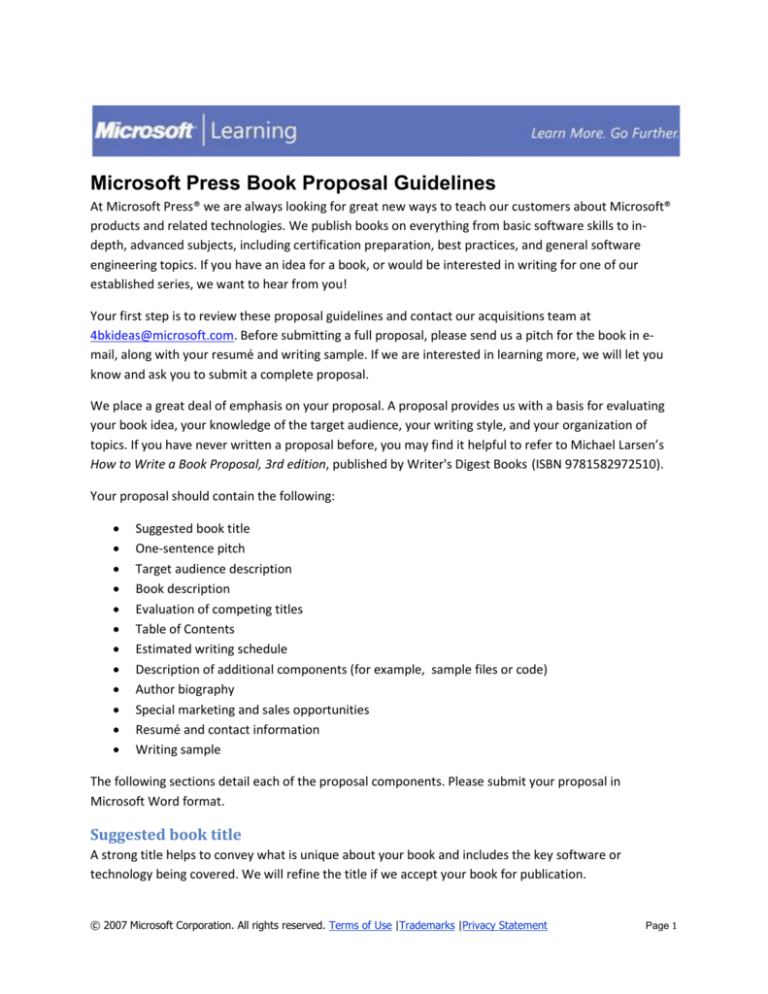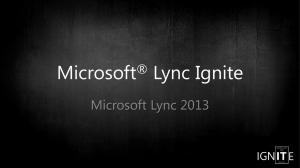
Microsoft Press Book Proposal Guidelines
At Microsoft Press® we are always looking for great new ways to teach our customers about Microsoft®
products and related technologies. We publish books on everything from basic software skills to indepth, advanced subjects, including certification preparation, best practices, and general software
engineering topics. If you have an idea for a book, or would be interested in writing for one of our
established series, we want to hear from you!
Your first step is to review these proposal guidelines and contact our acquisitions team at
4bkideas@microsoft.com. Before submitting a full proposal, please send us a pitch for the book in email, along with your resumé and writing sample. If we are interested in learning more, we will let you
know and ask you to submit a complete proposal.
We place a great deal of emphasis on your proposal. A proposal provides us with a basis for evaluating
your book idea, your knowledge of the target audience, your writing style, and your organization of
topics. If you have never written a proposal before, you may find it helpful to refer to Michael Larsen’s
How to Write a Book Proposal, 3rd edition, published by Writer's Digest Books (ISBN 9781582972510).
Your proposal should contain the following:
Suggested book title
One-sentence pitch
Target audience description
Book description
Evaluation of competing titles
Table of Contents
Estimated writing schedule
Description of additional components (for example, sample files or code)
Author biography
Special marketing and sales opportunities
Resumé and contact information
Writing sample
The following sections detail each of the proposal components. Please submit your proposal in
Microsoft Word format.
Suggested book title
A strong title helps to convey what is unique about your book and includes the key software or
technology being covered. We will refine the title if we accept your book for publication.
© 2007 Microsoft Corporation. All rights reserved. Terms of Use |Trademarks |Privacy Statement
Page 1
One-sentence pitch
What is the unique selling proposition for your book—why would a customer purchase this book?
Target audience description
Describe the target audience in detail, including skill level, job roles, what information or training your
audience needs, and where you think they usually obtain the training.
Book description
Please provide as much detail as possible, considering the following:
What is the purpose of the book and why does the audience need it?
What skills will the reader need to bring to the book and what skills will the reader take away?
What software and technologies will be covered?
What is your approach to presenting the material?
Evaluation of competing titles
Include title, author, publisher, and ISBN for competing titles, along with a brief assessment of each
book and how your book is different.
Table of Contents
The Table of Contents should contain the following information:
Outline consisting of section titles, chapter titles, and first-level heading titles in each chapter
Estimated page count for each chapter
One-paragraph description of each chapter
Estimated writing schedule
If your proposal is accepted and we sign a contract, we will work with you to fine-tune your writing
schedule. However, in order to assess your proposed timeline, please provide the following information:
Proposed title of each chapter and appendix
Author of each chapter and appendix (if there is more than one author)
Estimated page count for each chapter and appendix
Estimated date when you expect to hand off each chapter to Microsoft Press
When estimating chapter hand-off dates, please keep in mind that book manuscripts tend to take longer
to write and edit than anticipated. A successful formula that many experienced authors often use, for
example, is that you will spend approximately 30 percent of your authoring time incorporating
comments and feedback from your editors and technical reviewers. So please consider no more than 70
percent of your authoring time to be available for writing new chapters.
Also, we encourage you to submit your chapters to your peers who have expertise in the subject so that
you can get their feedback before you submit the chapter to our editing team. Please allow three weeks
in your schedule per chapter for this process.
© 2007 Microsoft Corporation. All rights reserved. Terms of Use |Trademarks |Privacy Statement
Page 2
Description of additional components
Describe extra components you would like to include, such as sample files, code, templates, job aids,
and supplementary resources.
Author biography
For many readers, the author’s background and expertise are key selling points. Please provide a one to
two paragraph biography suitable for inside the book that highlights your credentials as a subject matter
expert and as an author, plus any other relevant information. If there is more than one author for your
book, please provide a biography for each.
Special marketing and sales opportunities
Authors who promote their own books play an important role in building awareness and generating
sales. Please provide ideas for how you would be able to help promote your book. Do you write for any
Web sites, magazines, or blogs? Do you know which newsletters and RSS feeds target your audience? Do
you know or work with industry or community leaders, bloggers, reviewers, or Microsoft customers? Do
you speak at conferences?
Resumé and contact information
Please provide your resumé or curriculum vitae (CV), telephone number, and e-mail address. If there is
more than one author for your book, please provide the information for each.
Writing sample
Authors who have not previously worked with Microsoft Press must include a writing sample. The
sample can be a published work such as another book, an article, a white paper, etc., or a non-published
work. If you do not have any examples available, please write and submit one sample chapter. If there
are multiple authors, each author must submit an original work.
Tips for first-time authors
Consider being a contributor, coauthor, or technical reviewer before attempting an entire book.
Get experience writing articles for Web sites and technical magazines.
Timing is important! We start work on our publishing plan 18 months prior to software
launches. When you consider a new book, consider that it is hard to sell a general tutorial on a
product six months after the product releases. However, six months after a product releases
might be the perfect opportunity to publish something fresh and innovative.
If you have expertise in more than one technology, let us know—we may have another project
for you.
Share your expertise by becoming a trainer or public speaker—many of our authors also
participate at industry conferences and events.
Learn more about your potential audience and share your knowledge by participating actively in
the technical community. You might want to investigate the Microsoft Most Valuable
Professional (MVP) program. For more information, visit http://mvp.support.microsoft.com
Make sure you have seen what else we are publishing and send us something different!
© 2007 Microsoft Corporation. All rights reserved. Terms of Use |Trademarks |Privacy Statement
Page 3
Every book has competition. If there is not a book that competes directly on the exact topic, to
what can your book be compared? What other similar books would your reader already own?
What other sources do they use for technical information (for example, white papers, TechNet,
or MSDN®)? You need to be able to explain where your book fits within the existing
informational landscape.
Think of back cover copy when you write the proposal—what information do you want to
convey to the reader? Why would they pick up this book and not another one? What is your
“hook”?
A comprehensive, beginner-to-expert, everything-you-need-to-know “big book” approach is
often less useful than a smaller, focused book that can reach the audience more quickly,
targeting a specific information need. Your readers do not need to know all that you know—
they need to know the parts we promise to teach them.
After you submit your proposal
Your proposal will be routed to the appropriate Product Planner, who will evaluate it. We will contact
you if we have any questions, and you will be informed when we make a publishing decision.
Legal Notice: The receipt of a proposal and/or any and all discussions regarding the proposal does not obligate Microsoft in any
way. Microsoft is not contractually obligated to those entities providing proposals unless and until a formal contract is executed
by the entity and Microsoft. You should retain a copy of your proposal—any data and writings you submit to Microsoft for
proposal consideration may not be returned to you.
© 2007 Microsoft Corporation. All rights reserved. Microsoft, Microsoft Press, and MSDN are trademarks of the
Microsoft Corporation in the U.S. and other countries.
© 2007 Microsoft Corporation. All rights reserved. Terms of Use |Trademarks |Privacy Statement
Page 4





